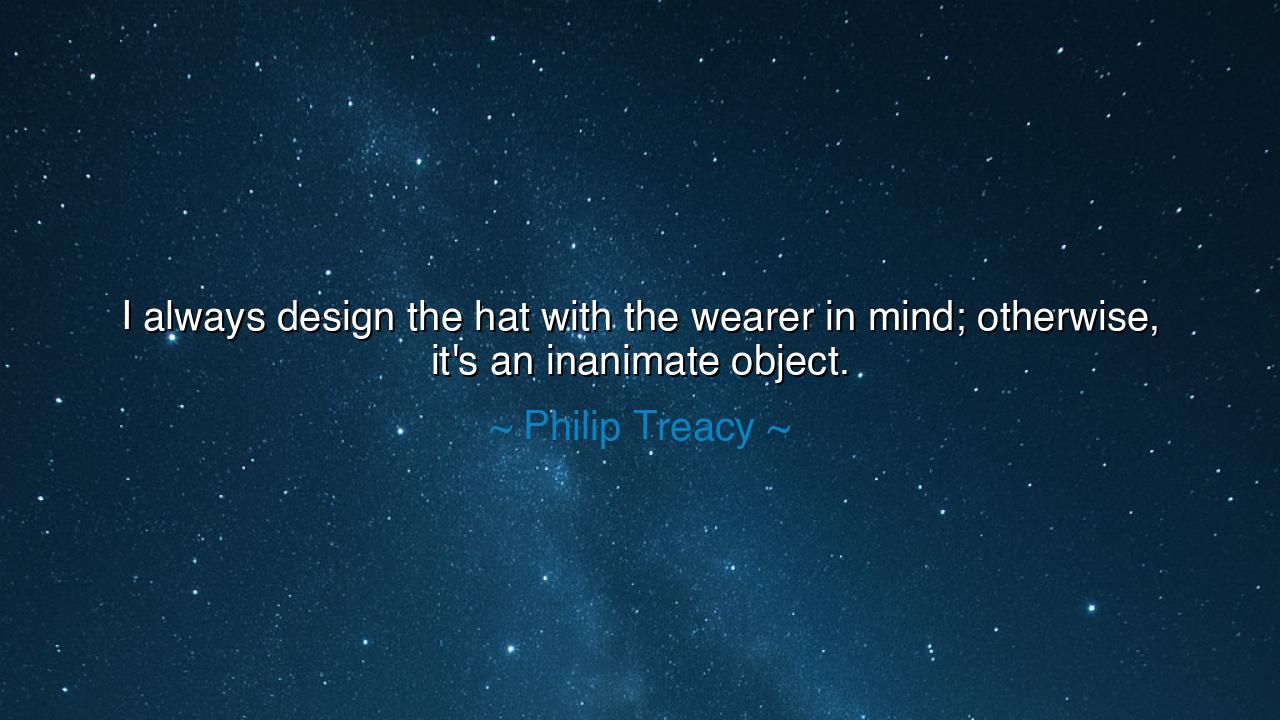
I always design the hat with the wearer in mind; otherwise, it's






“I always design the hat with the wearer in mind; otherwise, it's an inanimate object.” Thus spoke Philip Treacy, the great milliner whose creations have graced queens, icons, and dreamers alike. In these few simple words lies a truth far greater than the art of hat-making—it is the truth of creation and purpose. For Treacy reminds us that beauty without soul is but emptiness, and form without connection is lifeless. The hat, in his eyes, is not merely an ornament of fashion, but a vessel of spirit. It comes alive only when it meets the person for whom it was conceived—when it becomes part of a human story.
To design with the wearer in mind is to recognize the sacred bond between creator and creation, between art and life. The ancients understood this well. The sculptor of old did not carve marble for marble’s sake; he sought the divine figure within the stone. The poet did not write for words alone, but for the soul that would one day receive them. Likewise, Treacy sees the hat not as an object to be admired on a pedestal, but as a living extension of the self—a conversation between the imagination of the maker and the essence of the wearer.
In the heart of this teaching lies a principle of empathy. To truly create is to see beyond oneself. It is to enter into the life of another, to understand their dreams, their fears, their dignity, and their power. When Treacy designs, he listens—not only to fabrics and feathers, but to the silent story of the person who will wear them. Without that listening, he says, the hat remains inanimate—devoid of breath, spirit, and meaning. But with it, the object becomes enchanted; it becomes a mirror through which the wearer may glimpse their most radiant self.
Think of Leonardo da Vinci, whose portraits breathe life centuries after his hand has turned to dust. He painted not the surface of faces, but the souls behind them—the quiet strength of the Mona Lisa, the divine mystery of the Madonna. His art lives because it was made with the subject in mind. The same principle animates Treacy’s words: that art without human presence is hollow, but art born of understanding is eternal.
So too in life, this wisdom applies beyond artistry. A teacher who teaches without regard for the student imparts only noise; a leader who leads without thought of the people builds only monuments to his ego; a craftsman who labors without love produces only things, not treasures. To create for others is to breathe life into the world. To forget them is to fill the world with objects—cold, empty, and soon forgotten.
The hat, then, becomes a symbol of all human creation. It represents the meeting point between vision and identity, between the dream of the maker and the confidence of the wearer. When placed upon the head, it crowns not just beauty, but individuality. It reminds us that every act of creation—whether a work of art, a meal, a melody, or a moment of kindness—should be offered with the recipient in mind, for only then does it carry warmth and truth.
Let the lesson of Treacy’s words be carried into all corners of your life: do nothing without heart. When you speak, consider who listens; when you work, remember who benefits; when you love, do so with presence and understanding. For what is made without care dies quickly, but what is shaped by love lives on.
And so, in the end, a simple hat becomes a profound parable. In the hands of a master, it is no longer cloth and wire—it is imagination taking form, soul finding shape. It becomes animate because it was made with intention, with the wearer in mind. And that, dear listener, is the secret of all true creation: that we breathe life into what we touch only when we create it not for ourselves, but for another.






AAdministratorAdministrator
Welcome, honored guests. Please leave a comment, we will respond soon